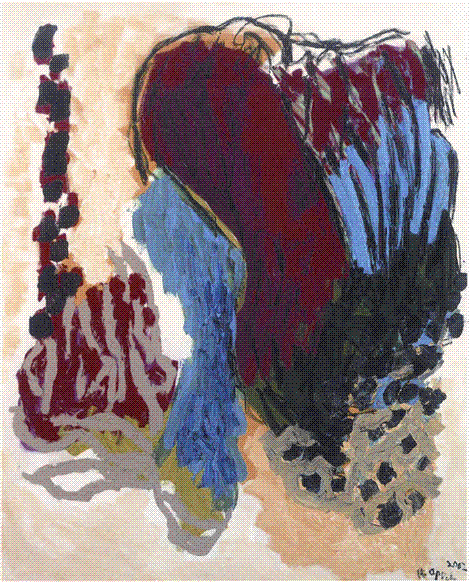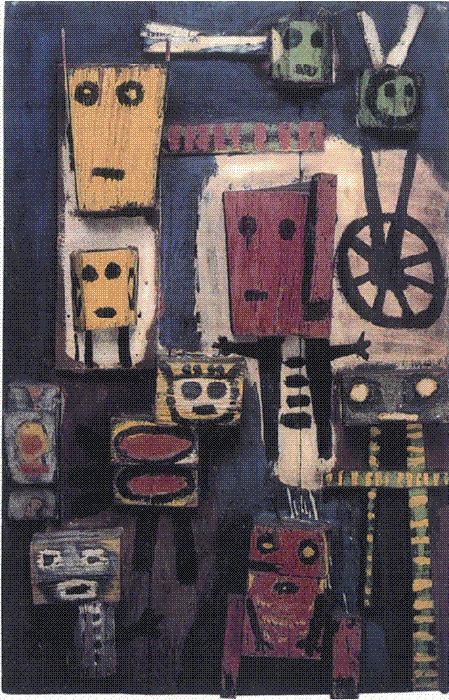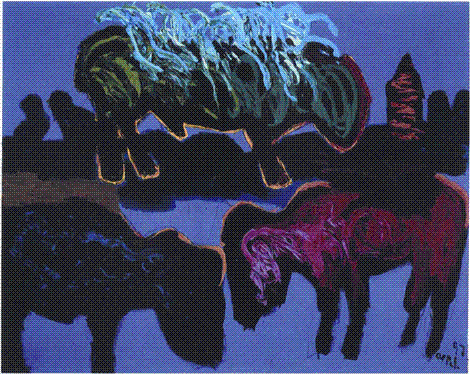|
| |
| |
| |
The Song of the Inner Voice
Karel Appel's Serial Versatility
[Frank van der Ploeg]
The song of the inner voice
who lives on the mountain top
who does not want to be seen
let us now start that song
without words, without music
(let's not do anything for at least ten minutes)
That's the spirit, there he comes
the song of the inner voice
the song of the primitive man
Karel Appel, 1981
From Karel Appel. The Colourful Stranger. Poems and Drawings
(Karel Appel. De kleurige onbekende. Gedichten en tekeningen). Amsterdam, 1986.
At the opening of an exhibition in September 2002 the writer/poet Remco Campert addressed these words to an audience of bankers and artists:
Long ago, in the Fifties, I was a member of a group of experimental poets. We wanted to revitalise poetry. We thought that the poetry that was being written at the time was dull. Something had to be done about it.
The poetical Establishment of the time did not appreciate our endeavours. The SS was said to have invaded poetry.
We were friends with a young group of artists who have gone down in art history as COBRA. Painters like Karel Appel and Corneille were among them.
If anything the painters were even more abominated than we were. Their paintings could only mean that the end of Western civilisation was nigh.
| |
| |
In the newspapers fathers who had been exposed to a painting by Appel were quoted as saying that their small daughters could do that too.
Mothers didn't have much to say for themselves in those days. They were only allowed to air their views on soap powders.
‘My small daughter can do that too.’
Father meant that it couldn't be much chop if his daughter could do it too. It can't have been very nice for the little girl - to hear that she was as bad as Karel Appel. Daddy must hate her, just like he hated Karel Appel. That his daughter was a genius did not occur to him.
That was long ago.
Nowadays fathers fortunate enough to possess small daughters who can do it just as well as Karel Appel would cherish their little girls as though they were budding tennis stars. Their eyes would gleam with a love driven by the thirst for gold.
Apart from entertaining his audience that evening, Campert put his finger on the essence of the Dutch painter Karel Appel's artistry. Reviled in his youth to such an extent that he sought refuge elsewhere in the world, and subsequently lionised.
Karel Appel (1921-) who in the fifties himself said ‘I just mess around’, is now generally acclaimed as one of the genuine innovators of modern painting. His controversial breakthrough came in 1949 when he was seen as one of the leading lights of the CoBrA group (the first letters of Copenhagen, Brussels and Amsterdam). In 1948 Appel had been one of the originators of the group. Together with Corneille and Constant among others he had already set up the Experimental Group Holland earlier the same year. CoBrA became official on 8 November; its members, along with the Dutch painters, were the Belgians Joseph Noiret and Christian Dotremont and the Dane Asger Jorn. The group made its breakthrough at the International Experimental Art Exhibition held in 1949 in the Stedelijk Museum in Amsterdam. All three of the Dutch artists who exhibited then are still alive and active. Corneille is also in his eighties and has become a household name and work by Constant (Nieuwenhuys) was on show at Dokumenta 11. Appel himself is still breaking new ground.
In a 1995 interview with Rudi Fuchs Appel says about growing older: ‘When you get older as a painter and you've got the opportunities, the talent and the good fortune and have been provided with everything for getting old, then it's fantastic, because the same brushstroke that you put down is more mature and more poignant than it was when you were young.’
| |
Matter
Appel's paintings from 2002 shown in the Viennese Ulysses Gallery the same year are completely abstracted landscapes, executed with a modern use of colour that is refreshing. Only rarely has Appel suppressed figuration to such an extent. The choice of material is also unusual: here he uses oil stick, oil paint and acrylic paint. Appel has regularly used acrylic paint in his drawings and as a finish for his sculpture, but for paintings it is out of the ordinary. In interviews he has always said he would not abandon oil paint. What is more, he has his own secret formula: eggs and 17th-century stand oil. In an interview in Elsevier (22 December, 1990) Appel said: ‘I'm able to paint so nice and thick with those big
| |
| |

Karel Appel, Mutation in Motion, 2002. Acrylic, oil stick and oil on canvas, 160 × 130 cm. © Karel Appel Foundation / sabam 2004. Courtesy of Galerie Ulysses, Vienna.
splodges that stay upright because I mix my own paint. I use the formula that the seventeenth-century painters used and I've added one or two things myself. A very important element is stand oil. I once got hold of a whole barrel full and I'm still using it. There are pots of it in all my studios, in New York, in Connecticut, in Monaco, and in Tuscany.’ The oil had been found when an old paint shop closed down. ‘Stock that had been there since the seventeenth century. [...] I mix my oil paint with it, and I throw in a lot of eggs and some concentrated turpentine. It's as thick as homemade mayonnaise. When it dries it is as tough and hard as rubber.’
| |
Downfall of the West
The critics quoted by Campert were not so wide of the mark with their ‘downfall of the West’. Shortly after the Second World War Appel wanted to free himself of ‘two thousand years of Europe’. It began in his studio in Amsterdam in 1947. He painted gouaches in the dark. As he confided to Rudi Fuchs in 1990 ‘at least fifty, one after another. Then I made a light, a candle, and I picked them up
| |
| |

Karel Appel. Inquiring Children. 1949. Oil on panel, 107 × 66 cm. Stedelijk Museum, Amsterdam. © Karel Appel Foundation / sabam Belgium 2004.
and turned them around, as I couldn't see a top or a bottom. I finished them off as I felt fit, a bit more white or a red spot’. Characteristic of his work in the CoBrA period is the rendering in paint of the play of lines and planes in children's drawings. This source of inspiration also lies behind the works, like Inquiring Children, Appel's comment on the use of nuclear weapons, also inspired by German children begging, whom he saw from a train.
After the CoBrA period - Appel often emphasises that this period was less important for him than is usually suggested - he began to paint more violently. The emphasis comes to lie more on the physical aspect of painting. In 1961 the cineaste Jan Vrijman recorded Appel's way of working in The Reality of Karel Appel (De werkelijkheid van Karel Appel) with music by Dizzie Gillespie and Karel Appel himself (‘Musique Barbare’). In order to make this film, a hole was made in a canvas on which he could work. The painter attacks the camera as if it were an empty canvas.
This improvisational way of working - Appel whacks the paintings, hits them with palette-knives, and squeezes out tube after tube, sometimes using both hands at once - comes close to Action Painting. But Appel is not really after
| |
| |
(abstr)action. He has a story to tell. His method can be compared with that of the improvising jazz musician - Appel is a jazz lover - and an emotional symbolism permeates his paintings.
Appel's point of departure is always emotion. The child is a quantity to be reckoned with in Appel's work, as is the sense of complete freedom that is found in the work of the mentally ill and ‘primitive’ peoples. In the conversation with Fuchs in 1990 Appel also says himself: ‘I have painted like an ape. The ape phase is in all my work. My first lick of paint is the ape phase, from that I grow towards a more intellectual phase, involving the lines, the rhythm. From that phase

Karel Appel, Up to the Sky. 1998. Oil on canvas, 200 × 260 cm. Private collection. © Karel Appel Foundation / sabam Belgium 2004.
I grow towards mankind, for that is where the power of my imagination lies. It no longer has anything to do with reality, even though the world is present in it - for we recognise people, animals, plants, you name it.’
| |
Series
Karel Appel works in series. Once an idea is born, he continues with it until he feels the time has come to conclude a particular exploration of form and sensibility. The CoBrA period was really just as short and vehement as all the later cycles. Certain points of departure remain constant throughout his entire oeuvre: the human figure in particular, both nude and as an object of psychological study, and landscapes.
In recent decades Appel has been painting less impetuously than in the period from shortly after CoBrA until the mid-1970s. There are even some series that must be the fruit of serious premeditation. At the end of the seventies Appel experimented with paintings in which brush strokes of different colours are carefully alternated, a technique that he applied again, but much more freely, in 1998 in a series of landscapes: Up to the Sky.
| |
| |
This series was preceded by Horizon[s] of Tuscany in 1995 and Birth[s] of a Landscape (1996), both of which are reminiscent of the 2002 landscapes as far as the degree of abstraction is concerned, but with other basic elements and a very different choice of colour. The Tuscan landscapes are dominated by rolling horizontals, interrupted by vertical elements evoking trees and bushes. The Birth[s] of a Landscape read like primordial soup, in which, amid bubbling and seething, direction is sought.
If alongside these we put paintings from 1997, in which the landscape plays a supporting role, the diversity is complete. In that year Appel made a very varied series, in which his habitual subjects (people, animals and natural elements) were brought together under titles such as Japanese Landscape (Sag zum Abschied leise Servus), The Beloved Beheaded and Flying Buffalo. In these paintings wild brush strokes are superimposed on cool, virtually even surfaces. The variety in these five years is characteristic of Appel's entire artistry.
| |
Hybrid art
Right from the early days of his career Appel has made sculptures. His working method at that time - he felt stimulated by Picasso and Schwitters, of whom he saw exhibitions in the 1940s in the Stedelijk Museum, Amsterdam - differed little in essence from the way recent works were produced. But Appel is more an assembler than a sculptor. Although now and then he carves wood or models plaster his works are mainly assemblages. He recycles objets trouvés which appeal to him in some way or which invite reuse. An increasingly wide range of industrial leftovers is incorporated in the assemblages from the early Nineties. Appel has sheds full of stuff that he can mix and match as he pleases. He sometimes works for a year on an assemblage, putting it together, taking it apart again, until it is right, ‘exactly right’. He would never just fling something together.

Karel Appel. Flying Buffalo. 1997. Oil on canvas. 193 × 243 cm. Private collection. © Karel Appel Foundation / sabam Belgium 2004.
| |
| |

Karel Appel. Toys from the Attic. 1992. Oil and objects on canvas, 152 × 121 cm. Private collection. © Karel Appel Foundation / sabam Belgium 2004.
He models plaster and paints the parts with gusto and thus creates the necessary unity between materials that normally do not belong together. The combination of painting and sculpture is optimised in a number of works dating roughly from 1991-1994. Each time the basis was a painting on canvas to which he added objects he had usually found and painted. From the play of paint and objets trouvés he created new characters
In the catalogue Karel Appel. Sculptures 1936-2000 (Karel Appel. Beelden 1936-2000) Appel is cited by Franz-W. Kaiser as claiming that his art was a reaction to ‘a world that is becoming more and more primitive, where ethnic intolerance is once again rampant and where on the basis of such a primitive instinct people are prepared to wipe each other out with high-tech weapons’. These were almost prophetic words. Since 11 September 2001 the world seems to be becoming an increasingly unsafe place. Kaiser suggests that Appel endeavours ‘to unite all cultures and to bring about a new form of hybridisation and fusion’. Kaiser finds this desire ‘all the more understandable if we remember that Appel was very young when he left his native land and has since lived and worked for more than half a century in places all over the globe. [...] They are ultimately assemblages of fragments of a world culture - and that is Appel's culture’.
One of the most striking examples of a work that fits this description is The Irresistible Diversity of the Animal created in 2000. ‘Vuilnisbakkenras’ (‘garbagecan breed’), the Dutch word for a mongrel, could not be more appropriate. Not only are the origins of the different parts diverse, but also as an assemblage it remains an animal with an ambivalent character, a modern mythological animal, as it were a contemporary chimera.
| |
| |
| |
Back in Europe's bosom
For the birthday exhibition Pastorale Chiaroscuro publisher Johannes Gachnang wrote an article entitled ‘A High Chant of Man, or: What did Goya, Rembrandt and Van Gogh Last Paint? A Laughing Wood with Many Talking Trees’. Gachnang does not draw any parallels with Appel's famous predecessors, but I for one should like to do so. In 1998 Appel painted the above-mentioned series of land and skyscapes with the intriguing title Up to the Sky. With a slight stretch of the imagination the corn sheaves that Van Gogh, whom Appel so admires, painted shortly before his death, can be recognised - even in painting technique - in some of the works in this series. But Appel ‘simply’ carries on, as his 2002 series of landscapes attest.
The Karel Appel who freed himself of 2,000 years of Europe fifty years ago now emerges as a painter belonging entirely within a Western tradition, even a tradition with strong European roots. It is, however, a tradition which he himself has helped to shape.
Rudi Fuchs, ex-director of the Amsterdam Stedelijk Museum, will be the curator of a special Appel exhibition to be held at the Brussels Palais des Beaux-Arts, in Autumn 2004.
| |
Bibliography
| fuchs, rudi, et al., Karel Appel. Pastorale Chiaroscuro. Amsterdam / Rotterdam, 2001. |
| groenevelt, saar, Het atelier van Karel Appel in Kasteel Groeneveld. Baarn, 1999. |
| hofland, h.j.a., Karel Appel werk op papier. The Hague / Zwolle, 2001. |
| kuspit, donald, Karel Appel: Sculpture - A Catalogue Raisonné. New York, 1994. |
| stokvis, willemijn, The Language of Cobra. Amsterdam, 2001. |
| Karel Appel. De kleurige onbekende. Gedichten en tekeningen. Amsterdam, 1986. |
| Karel Appel. Ik wou dat ik een vogel was. Berichten uit het atelier. Amsterdam / The Hague, 1990. |
| karel appel. Beelden 1936-2000, Amstelveen, 2001. |
| |
Note
The author would like to record his indebtedness for this article to Madeleine Bischoff, who carried out preparatory research into the literature for the Artists' Interviews / Archives project of the Foundation for the Conservation of Contemporary Art. The foundation was set up with the object of gaining greater insight into the use of materials, technique and significance of the material in major artists. Its first publication, Modern Art: Who Cares?, appeared in 1999. Following on from this, artists are selected who are then interviewed in depth and an archive relating to them is created. Karel Appel is one of the artists who will be invited to take part. Further information: sbmk@icn.nl.
My thanks also to Remco Campert for making available the text of his speech delivered on the occasion of the opening of the exhibition Per Saldo: Honderd verrassende werken uit de abn amro kunstcollectie (about works from the abn amro art collection), 's-Hertogenbosch, 21 September 2002. |
|